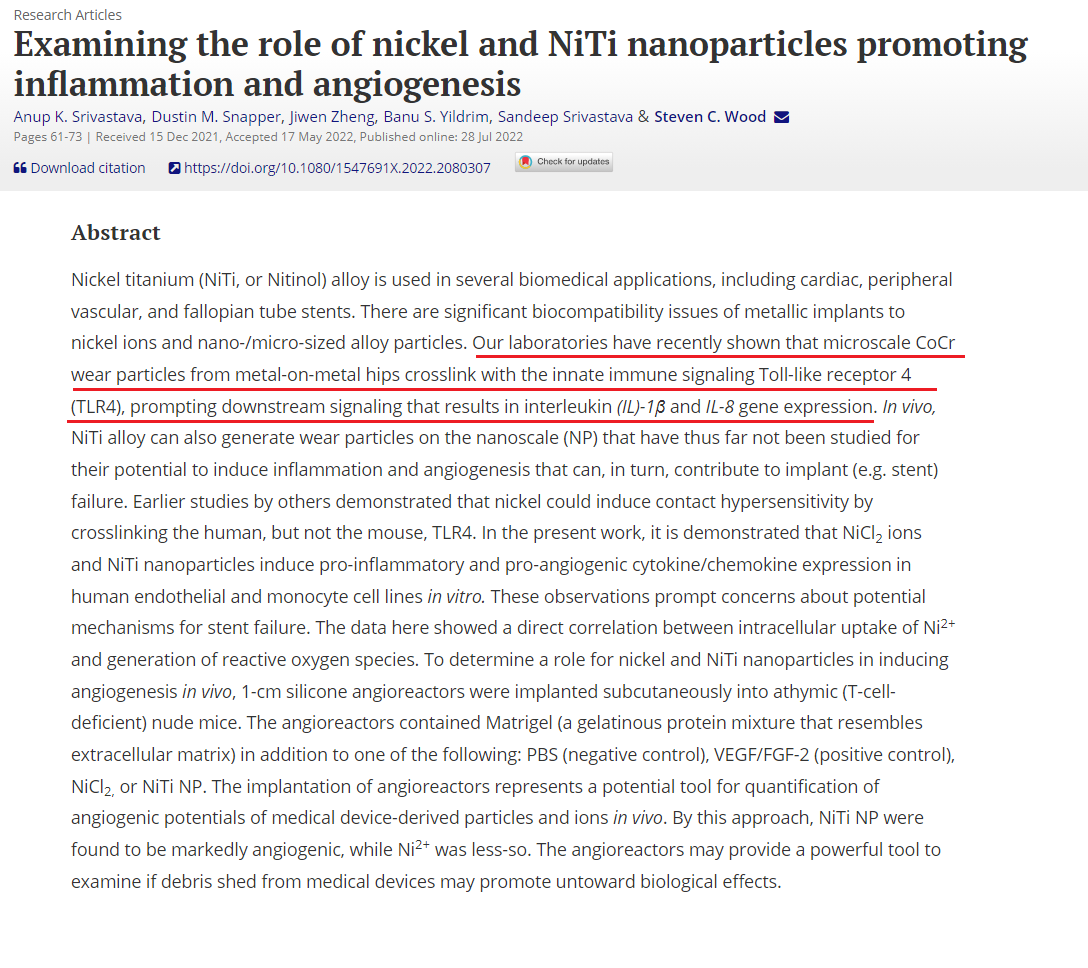Examining the role of nickel and NiTi nanoparticles promoting inflammation and angiogenesis
Anup K. Srivastava, Dustin M. Snapper, Jiwen Zheng, Banu S. Yildrim, Sandeep Srivastava & Steven C. Wood
https://doi.org/10.1080/1547691X.2022.2080307
Abstract
Nickel titanium (NiTi, or Nitinol) alloy is used in several biomedical applications, including cardiac, peripheral vascular, and fallopian tube stents. There are significant biocompatibility issues of metallic implants to nickel ions and nano-/micro-sized alloy particles. Our laboratories have recently shown that microscale CoCr wear particles from metal-on-metal hips crosslink with the innate immune signaling Toll-like receptor 4 (TLR4), prompting downstream signaling that results in interleukin (IL)-1β and IL-8 gene expression. In vivo, NiTi alloy can also generate wear particles on the nanoscale (NP) that have thus far not been studied for their potential to induce inflammation and angiogenesis that can, in turn, contribute to implant (e.g. stent) failure. Earlier studies by others demonstrated that nickel could induce contact hypersensitivity by crosslinking the human, but not the mouse, TLR4. In the present work, it is demonstrated that NiCl2 ions and NiTi nanoparticles induce pro-inflammatory and pro-angiogenic cytokine/chemokine expression in human endothelial and monocyte cell lines in vitro. These observations prompt concerns about potential mechanisms for stent failure. The data here showed a direct correlation between intracellular uptake of Ni2+ and generation of reactive oxygen species. To determine a role for nickel and NiTi nanoparticles in inducing angiogenesis in vivo, 1-cm silicone angioreactors were implanted subcutaneously into athymic (T-cell-deficient) nude mice. The angioreactors contained Matrigel (a gelatinous protein mixture that resembles extracellular matrix) in addition to one of the following: PBS (negative control), VEGF/FGF-2 (positive control), NiCl2, or NiTi NP. The implantation of angioreactors represents a potential tool for quantification of angiogenic potentials of medical device-derived particles and ions in vivo. By this approach, NiTi NP were found to be markedly angiogenic, while Ni2+ was less-so. The angioreactors may provide a powerful tool to examine if debris shed from medical devices may promote untoward biological effects.
Conclusions
The present study with THP-1 monocytes and EA.hy926 human endothelial cells showed how nickel and NiTi NP could alter viability, increase oxidation, and promote changes in gene expression associated with pro-inflammatory and pro-angiogenesis outcomes. Taken together, the results here demonstrated that nickel and NiTi NP can enter both types of cells, with deleterious consequences. With the widespread use of NiTi devices, more attention to localized tissue reactions is warranted to address concerns inspired by nickel ion release due to surface finish and/or NiTi NP that may be generated from corrosion or wear. The use of angioreactors here provided a unique means of evaluating in vivo potential untoward events of such medical devices wear particles.

See free reviews and follow our informative Blog to learn more: https://implante.institute/blog
See free analysis at: https://implante.institute/analises?perm_status=1
#implantinstitute #implantcontamination #contamination #implantlost #titanium #zirconia #metal #aluminumfree #toxic #alumina #odontistry #materialscience #cellbiology #implantdentistry #dentist #implant #dental #dentalcare #plantcontentental #esthetic #cell
